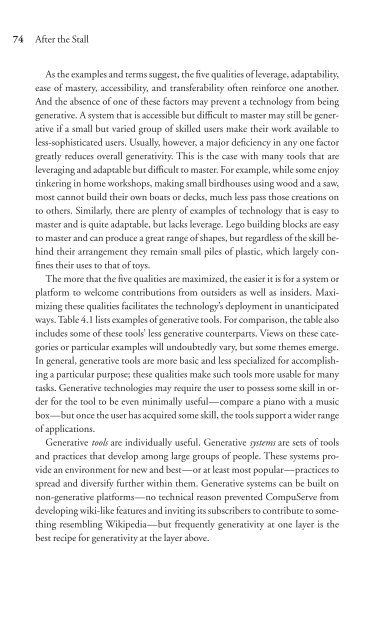Download - Future of the Internet â And how to stop it.
Download - Future of the Internet â And how to stop it.
Download - Future of the Internet â And how to stop it.
You also want an ePaper? Increase the reach of your titles
YUMPU automatically turns print PDFs into web optimized ePapers that Google loves.
74<br />
After <strong>the</strong> Stall<br />
As <strong>the</strong> examples and terms suggest, <strong>the</strong> five qual<strong>it</strong>ies <strong>of</strong> leverage, adaptabil<strong>it</strong>y,<br />
ease <strong>of</strong> mastery, accessibil<strong>it</strong>y, and transferabil<strong>it</strong>y <strong>of</strong>ten reinforce one ano<strong>the</strong>r.<br />
<strong>And</strong> <strong>the</strong> absence <strong>of</strong> one <strong>of</strong> <strong>the</strong>se fac<strong>to</strong>rs may prevent a technology from being<br />
generative. A system that is accessible but difficult <strong>to</strong> master may still be generative<br />
if a small but varied group <strong>of</strong> skilled users make <strong>the</strong>ir work available <strong>to</strong><br />
less-sophisticated users. Usually, <strong>how</strong>ever, a major deficiency in any one fac<strong>to</strong>r<br />
greatly reduces overall generativ<strong>it</strong>y. This is <strong>the</strong> case w<strong>it</strong>h many <strong>to</strong>ols that are<br />
leveraging and adaptable but difficult <strong>to</strong> master. For example, while some enjoy<br />
tinkering in home workshops, making small birdhouses using wood and a saw,<br />
most cannot build <strong>the</strong>ir own boats or decks, much less pass those creations on<br />
<strong>to</strong> o<strong>the</strong>rs. Similarly, <strong>the</strong>re are plenty <strong>of</strong> examples <strong>of</strong> technology that is easy <strong>to</strong><br />
master and is qu<strong>it</strong>e adaptable, but lacks leverage. Lego building blocks are easy<br />
<strong>to</strong> master and can produce a great range <strong>of</strong> shapes, but regardless <strong>of</strong> <strong>the</strong> skill behind<br />
<strong>the</strong>ir arrangement <strong>the</strong>y remain small piles <strong>of</strong> plastic, which largely confines<br />
<strong>the</strong>ir uses <strong>to</strong> that <strong>of</strong> <strong>to</strong>ys.<br />
The more that <strong>the</strong> five qual<strong>it</strong>ies are maximized, <strong>the</strong> easier <strong>it</strong> is for a system or<br />
platform <strong>to</strong> welcome contributions from outsiders as well as insiders. Maximizing<br />
<strong>the</strong>se qual<strong>it</strong>ies facil<strong>it</strong>ates <strong>the</strong> technology’s deployment in unanticipated<br />
ways. Table 4.1 lists examples <strong>of</strong> generative <strong>to</strong>ols. For comparison, <strong>the</strong> table also<br />
includes some <strong>of</strong> <strong>the</strong>se <strong>to</strong>ols’ less generative counterparts. Views on <strong>the</strong>se categories<br />
or particular examples will undoubtedly vary, but some <strong>the</strong>mes emerge.<br />
In general, generative <strong>to</strong>ols are more basic and less specialized for accomplishing<br />
a particular purpose; <strong>the</strong>se qual<strong>it</strong>ies make such <strong>to</strong>ols more usable for many<br />
tasks. Generative technologies may require <strong>the</strong> user <strong>to</strong> possess some skill in order<br />
for <strong>the</strong> <strong>to</strong>ol <strong>to</strong> be even minimally useful—compare a piano w<strong>it</strong>h a music<br />
box—but once <strong>the</strong> user has acquired some skill, <strong>the</strong> <strong>to</strong>ols support a wider range<br />
<strong>of</strong> applications.<br />
Generative <strong>to</strong>ols are individually useful. Generative systems are sets <strong>of</strong> <strong>to</strong>ols<br />
and practices that develop among large groups <strong>of</strong> people. These systems provide<br />
an environment for new and best—or at least most popular—practices <strong>to</strong><br />
spread and diversify fur<strong>the</strong>r w<strong>it</strong>hin <strong>the</strong>m. Generative systems can be built on<br />
non-generative platforms—no technical reason prevented CompuServe from<br />
developing wiki-like features and inv<strong>it</strong>ing <strong>it</strong>s subscribers <strong>to</strong> contribute <strong>to</strong> something<br />
resembling Wikipedia—but frequently generativ<strong>it</strong>y at one layer is <strong>the</strong><br />
best recipe for generativ<strong>it</strong>y at <strong>the</strong> layer above.


